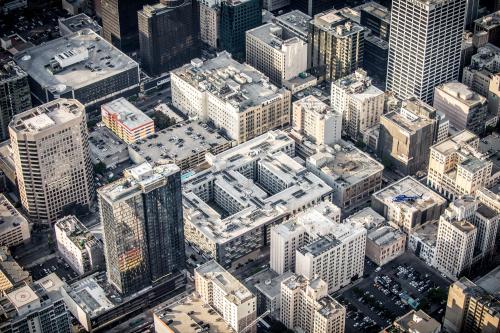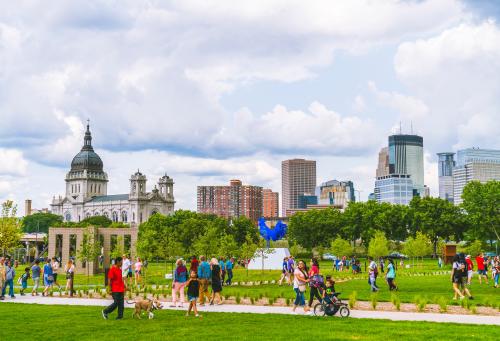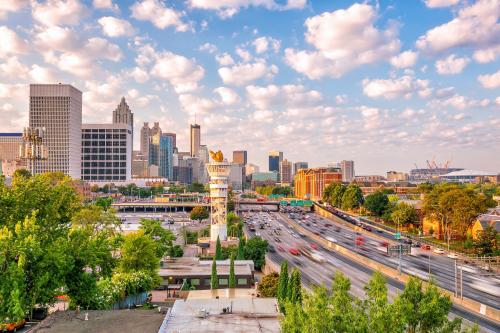And so, the prevailing narrative goes: urban areas are “back.” Job growth is shifting from sprawling suburbs to core city centers. Companies are relocating to attract educated workers who prefer accessible, amenity-rich neighborhoods. Density and accessibility are the watchwords, as high-growth firms favor mixed-use, walkable, and transit-rich neighborhoods in both cities and suburbs alike.
These trends show us that place matters as much as ever. Yet they also raise many questions for city and regional leaders about how pervasive and durable these trends actually are, what’s driving them, and how—at a time of rising metropolitan inequality—they might be harnessed to benefit more people and places.
A new report from the Bass Center for Transformative Placemaking offers some insight.
Where jobs are concentrating and why it matters to cities and regions looks at job density trends in 94 large metropolitan areas from 2004 to 2015, a time of dramatic economic change. It finds that the concentration of jobs in metropolitan America increased by 30%, which means that over this period, the average employee in these areas found themselves working in an increasingly dense environment. Density increases were particularly pervasive in sectors such as health care, education, hospitality, and arts and entertainment.
Within metropolitan areas, core urban counties experienced the most significant increases in job density, with downtown areas capturing much of the growth. Job density in Indianapolis, for example, rose by 46%, driven almost completely by greater concentration in the urban core and other already dense parts of Marion County. Similarly, Cleveland’s overall job density increase was driven by a 33% increase in its most populous county, Cuyahoga. Other metro areas, like Detroit, Albany, N.Y., Salt Lake City, and Charlotte, N.C. saw similar patterns, with the densest parts of their metros driving overall trends.
These findings confirm that the narrative of cities being “back” is based on some solid truths. But take a deeper look at the report’s findings and the story begins to take a few twists and turns.
More cities and regions need to be advancing policies and investment strategies that foster more concentrated growth patterns, while supporting placemaking solutions within these areas that help more businesses, workers, and residents thrive.
Indeed, while jobs across the country are becoming increasingly dense in the aggregate, this trend is highly skewed by San Francisco, Seattle, Chicago, and New York—regions we already know are attracting a substantial share of innovative firms and educated workers. Absent these four metros, metropolitan job density overall increased by just 9%. Meanwhile, only about half of all large metros saw any job density increase, while the other half saw jobs sprawl. These trends correlated with job growth, as metro areas with faster job growth also tended to see larger increases in job density, while slower growth areas tended to sprawl.
These findings suggest that more cities and regions need to be advancing policies and investment strategies that foster more concentrated growth patterns, while supporting placemaking solutions within these areas that help more businesses, workers, and residents thrive.

How can density benefit more people, across more places?
Areas of job concentration certainly do not equate to economically and socially dynamic communities—but they seem increasingly requisite for creating them.
Research shows that density, when coupled with good design and programming, has positive impacts on people, places, and the environment. Denser communities increase workers’ access to jobs, making it easier to find new (and better) job opportunities more often. Density lowers transportation expenses, making it easier and cheaper for people to get to work, and provides municipal fiscal benefits by reducing infrastructure costs. It provides social benefits, increasing interaction, connectedness, and trust among neighbors and enhances civic engagement through voting and contact with local officials, Finally, dense places are better for the environment, conserving energy, reducing pollution, and preserving natural resources.
But for all these positive impacts, density alone doesn’t lead to these outcomes—nor does it ensure these outcomes are widely shared. Density without investments in transformative placemaking may yield few if any advantages at all, particularly for those at the margins of our economy.
Rather, density must be coupled with good design and programming that builds upon an area’s existing assets and targets the barriers that are preventing them from being fully realized. There is no singular playbook for transformative placemaking—and it will constantly evolve—but there are a few guiding principles:
- Place: Transformative placemaking means targeting investments beyond downtown cores and toward communities whose strengths have been long overlooked and undervalued by both the public and private sector. It’s also about creating physical spaces and design patterns within those communities that help nurture local business development, creativity, and access for all residents. This includes civic spaces, from parks to libraries, that—when planned with inclusivity in mind— enhance socialization among diverse groups and build trust among them.
- People: Transformative placemaking means investing in people through skill development training, entrepreneurship programs, mentoring programs, and other efforts aimed at building on the existing capacities of local residents. These investments need to be coupled with policies that improve access to housing, transit, educational opportunities, healthcare, and other social supports that low-income residents need. As the Just City Lab reminds us: development can help combat urban inequality and disparity, as long as it is intentional about improving economic, health, civic, cultural, and environmental conditions for residents.
- Community: Transformative placemaking means that communities themselves drive the vision, implementation, and outcomes of their growth and development. Place-based civic infrastructure needs to be supported and sustained, and structured to ensure that all voices are heard, taken seriously, and continually consulted and engaged (not only when a big project is in the works). Project for Public Space’s guide for inclusive community engagement suggests several strategies for engaging communities in public space projects that are relevant to and can be scaled to address broader placemaking objectives.
The digital revolution is altering what people and businesses want from place, manifested in an increasing propensity of jobs, across nearly all industry sectors, to concentrate. Our research confirms that these shifts are far more pronounced in some places than others, likely both a reflection and a cause of large disparities in growth and investment. If a wider range of communities are to benefit from these trends, city and regional leaders need to be more attentive to the role that density and placemaking plays in helping people and places flourish—and ensure that far more of them become part of the narrative.







Commentary
Demands for place are reshaping our communities, but how can the benefits be more widely shared?
June 24, 2019